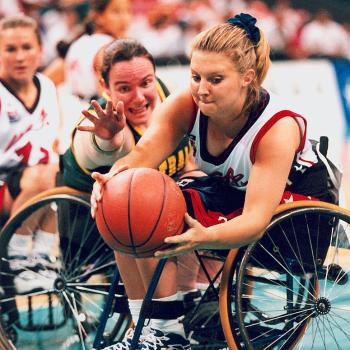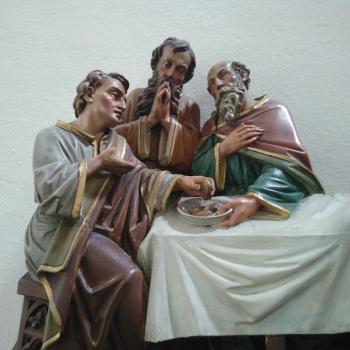I’m back from conference-land and that means it’s time to talk about Transgendered Nuns.
When I got the head’s up on this story a few days ago, I had one reaction and I’m sticking to it: This isn’t complicated, kids.
That is, unless you are sucked up into our hyper-ventilating, panic-addicted culture, and just desperately need something Shocking! to ooh and aah over. Otherwise, you can do the Catholic thing. We’ll do the Catholic thing:
1. Doesn’t matter what your past is. Christianity is about your future. No matter what you’ve done or who you’ve been, there’s a place for you in the Catholic Church.
2. The general rule — and it’s pretty firm — is that boys-will-be-boys and girls-will-be-girls. So if you knock on the door of your local convent explaining that you had yourself castrated and now you’re ready to join the ladies at prayer six hours a day, if it’s a Catholic convent they’ll gently redirect you to the monastery across the lawn. You can remove or reconfigure any body part you like, your essential identity as male or female is unchanged.
There’s a Bible verse about this, sort of not really, but that reminds us there’s nothing new under the sun. It takes balls to become a consecrated religious, but it’s of the spiritual type, not a physical test.

3. Whimsical historical interlude to remind you that rules are made to be broken: Browse the pages of Butlers Lives of Saints, and you’ll run across a handful of recurring types of legendary saints. Whether the stories repeat because of confusing identity, or pious legend, or because there really were several saints who worked the same feats — it hardly matters. Butler just reports what the sources say, and leaves you to make of it what you will. One of the saintly types we encounter at multiple turns is the female saint who disguises herself as a man and enters the monastery. The story runs about like this:
- For some good reason, St. Crossdresser feels the need to disguise herself as a man.
- She’s a saint, so of course she behaves well (and chastely).
- Her piety irks the onlookers. An enemy accuses her (thinking her a “him”) of a scandalous liason. St. Crossdresser is alleged to be the father of some fatherless child.
- Due to her extreme humility and attitude of penance, St. Crossdresser never denies the charges, but meekly assumes responsibility for providing for the mother and child.
- The truth is only revealed at the saint’s death.
So there you go. Back before people got shocked! just shocked! at Christians wearing all the wrong clothes, there was actually a cross-dressing saint thing going on. It’s funny about chastity — it has a way of turning all kinds of unusual situations into non-problems.
4. So. Unusual situations. The case in Ontario appears — the reporting is a little vague — to be about one of the many of what are referred to as “intersex” variations on human development. I use quotes because if you browse through wikipedia’s list, a very many of the conditions that get lumped into this broad category are not really gender problems.
In a significant portion — not all — of the conditions that get called “intersex”, the individual’s gender is not up for debate. You’re clearly female, but you have a hormonal or physical disorder that makes you look not-so-girly. Or you’re male, but the hormones give you larger breasts and less manly-man genitalia than average. In our image-obsessed, cult-of-beauty society, grade school lunch room humor is the order of the day; heaven help you if you’re a kind, caring, wonderful person who isn’t pretty or handsome enough to meet spec. Grown-ups, meanwhile, observe that the proper course of action is to rectify any medical problems as much as possible, and make up for the rest with a generous dollop of human respect.
There is, by the way, no impediment to marriage for the man or woman who has such a disorder, as long as the marital act can be completed. Fertility is not a prerequisite for marriage. (An unconsummated marriage, on the other hand, can indeed be annulled. The marital act is essential to the sacrament.)
5. It’s not always so easy. Medical science tries hard, but sometimes gets it wrong. This was especially true in the days before genetic testing was widespread. There are known cases of children with ambiguous genitalia being assigned the wrong gender at birth. When the error is revealed, despite the awkwardness it’s best to go ahead and make the social changes necessary to align the child’s identity with, well, his or her identity.
Likewise, if ain’t broke don’t fix it. I can think of no reason for a contentedly female-from-birth to be forced into a male identity on account of gene testing that might have come up incidentally during some other medical test.
6. What to do with the true hermaphrodite? Let us consider the possibility of the rare person who is neither clearly male nor clearly female, even after working through all the medical problems that can confuse.
Okay, well, we have to decide which locker room to use. An “M” or an “F” goes on the paperwork. Pick a pronoun. And that’s about it.
7. After all that, the Christian life is pretty straightforward. Can every Christian be married? No. Can every Christian be a priest? No. Can every Christian be a religious brother or sister? No. Consecrated virgin? No. Hermit? No. None-of-the-above? No. We all have a call to chastity, holiness, and total giving-of-self in a life of love. The form that calling takes will vary.
Every single one of us has a calling unique to our own lives, our own circumstances, our own good gifts and holy inclinations.
But one thing you don’t have to be is “normal”. Christians have a calling to many things, but “fitting in” is not one of them. God doesn’t necessarily ask you to be normal. He asks you to be obedient, faithful, loving, chaste . . . but the details are wonderful and varied.












